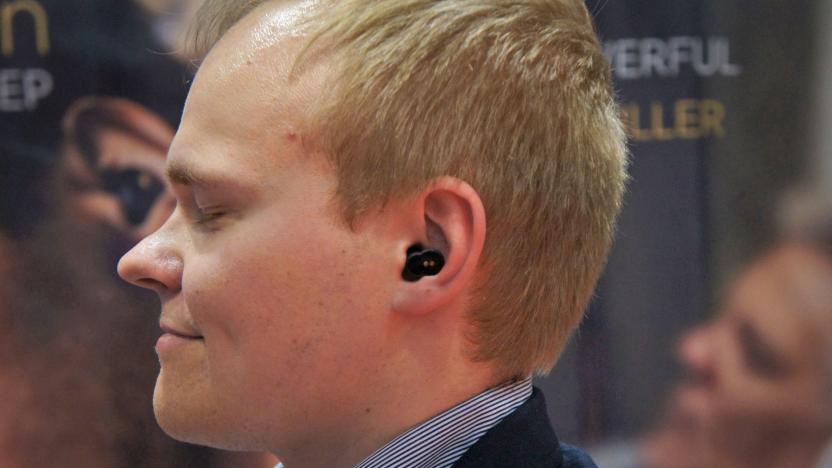activenoisecancellation
Latest

Marshall's Mid ANC are a worthy pair of noise-canceling headphones
Last year, Marshall introduced its highest-end wireless headphones, the Monitor Bluetooth. They had almost everything you'd want in cord-free cans -- except for active noise cancellation (ANC). Now, Marshall is finally jumping aboard that bandwagon with the $269 Mid ANC. While they're technically part of the company's mid-range lineup, the addition of noise cancellation might make them worth the $30 premium over the $249 Monitor Bluetooth.

QuietOn’s new noise-cancelling earbuds banish the sound of snoring
Does your significant other snore while they sleep, soundtracking your night with the sound of rocks falling down a mountain? Are you flirting with the idea of getting the lawyers in? Because Finnish company QuietOn is hoping to restore harmony in the bedroom with its latest invention, the QuietOn Sleep.

Blue raises the bar for wireless audio with its Satellite headphones
After making its name building microphones for both amateurs and professionals, Blue made the leap to headphones back in 2014. Its first model, the Mo-Fi, featured a built-in amplifier and the company followed up with three others, including a planar magnetic set that also has an onboard amp. All of those options were wired, though, and if we've learned anything about "courageous" smartphone makers these days, the headphone jack is on its way out. To cater to the wireless craze, Blue announced its first wireless headphones, the Satellite, at CES in January. While this $400 model features and amp for top-notch audio, the Satellite lacks a key selling point for headphones: comfort.

SXSW showed me Here's Active Listening buds are a sound idea
"SXSW is all about the big ideas." I've been saying it all week long. It's true. Here in Austin is not the place to launch a phone, it's where you show an idea about how to get people to Mars, or how to feel g-force in mobile VR. This is where apps like Twitter and Foursquare breakthrough and gain mainstream popularity. It's where vaporous ideas can crystalize into something people understand. Here -- a pair of earbuds that modify the audio around you -- had me struggling to understand them. Until this weekend, that is.

Sennheiser made its great Momentum headphones even better
Since its introduction in 2013, Sennheiser's Momentum line headphones have added not only new color options, but on-ear and in-ear models, too. During that time, I've been quite impressed by the cans and their clear and balanced sound. At CES, wireless versions of the over-ear and on-ear gadgets made their debut, and when the news hit, I immediately wondered if the Momentum Wireless would be better than the original. After trying them out, I can confidently say that Sennheiser has made a good thing even better.

Parrot Zik by Starck review: Is $400 worth it for the fanciest, techiest headphones around?
You do know that Parrot makes more than just the AR.Drone, right? It was at CES earlier this year that we first caught a glimpse of -- and subsequently began geeking out about -- the Parrot Zik by Starck. For those unfamiliar, these headphones are jam-packed with enough technologies to make even the geekiest audio lovers smitten. Priced at about $400, they feature Near Field Communication (NFC), Bluetooth connectivity, on-board capacitive touch-control, active noise cancellation, head detection, a jawbone sensor for speech and Parrot's audio-enhancing DSP app for iOS and Android -- not to mention a striking design by the renowned Philippe Starck. This isn't the first time Parrot and Mr. Starck have worked together, but this does mark their debut in the portable audio market (as opposed to home-based speaker systems). In the case of this review, not one, but two Engadget editors spent some time testing the product. So, do they impress? More importantly, are they worth the $400 asking price? You know the drill: meet us after the break where we'll lay it all out.

Parrot Zik launching in August for $399, free app included for iOS and Android
Remember those cool-looking Parrot Zik wireless headphones we saw back at CES? Well, now we have a date and a price for you Philippe Starck fans out there. Announced at the Hong Kong launch event earlier today, these NFC-enabled, active noise cancelling Bluetooth cans will be available globally in August, with the US getting a price tag of $399 before tax (and for those who care, you'll be able to nab one in Hong Kong for HK$3,399 or US$440). During our brief ears-on, we certainly enjoyed the Zik's great audio quality, noise isolation and the intuitiveness of its swipe gesture input. While the battery is swappable, note that this expensive package only comes with one cell (accessible under the magnetic cover on the left can) that typically lasts for around five hours, so road warriors will need to chip in about $30 for a spare one. Alternatively, product manager Theodore Sean (whom we had the pleasure to interview at CES) pointed out a unique and handy feature that sort of bypasses this problem: you can still use the Zik as a pair of passive headphones using the included 3.5mm audio cable, but without any battery juice left, you obviously won't be able to enjoy the noise cancellation function (on a plane, for instance) or even make phone calls. %Gallery-159769%

Klipsch Mode M40 noise-cancelling headphones review
Around these parts, we've generally had favorable opinions of Klipsch's audio products. Whether it's been something as small as its S4 line of smartphone oriented in-ears or grand speaker systems like its AirPlay-enabled G-17 Air, we've usually ended up awarding the brand our highest praise. If you'll recall, it was little over a year ago that Klipsch introduced its $150 Image One on-ear headphones -- the company's first set ever that weren't of the intra-aural variety, and a favorite of our own James Trew. Fast forward to the present, and the company's unleashed its second proper over-the-head headphone, the Klipsch Mode M40 with active noise-cancellation. In recent years, headphones have exploded in popularity -- many companies have been furiously trying to blend good sound with fashion-forward looks. It's safe to say that's Klipsch's end game here, and is asking that you part ways with 350 bones to get in on the action. Put simply, these aren't a follow-up to the Image Ones, but rather, a luxury pair that takes cues from the company's reference series headphones. Of course, as we've come to expect from Klipsch, the M40s do have some notable tricks up their yokes aside from their debatably fashionable looks -- the company promises they'll cancel noise for a massively long 45 hours on a single AAA battery, and both earcups feature an interesting dual-driver array with a 15mm tweeter and a 40mm woofer. So, have the M40s made us smitten with Klipsch all over again? Or not? Maybe something a bit more complicated? Click on past the break to find out!

Parrot reveals Starck-designed Zik Bluetooth touch-activated headset, Zikmu Solo wireless tower speaker (hands-on)
Parrot's AR.Drone 2.0 may have been one of the more joy-inducing wares we've seen here at CES, but that was yesterday. Today, we dare to say that that one of two audio devices just unveiled (and designed by Philippe Starck, we might add) has our jaw dropping, and our ears tingling -- the absolutely gorgeous Zik Bluetooth touch-activated headset, pictured above. The Zik's loaded with goodies -- Bluetooth connectivity, active-noise cancellation, NFC and touch controls on either earcup, not to mention its jawbone and "presence" sensors among a few other notable tidbits like its DSP-enabling app that adds a "concert-type" vibe to its sound. As far as that second device goes, Parrot's introducing a singular stereo version of its Zimku wireless tower speakers, aptly named Zikmu solo. Head past the break to find our brief impressions and a video overview of a pre-production Zik, and hit up the galleries below for some closeup shots of it and the Zikmu solo.

GM shows off Terrain SUV with noise cancellation, says silence equals fuel efficiency
GM claims its new Terrain has other SUVs beat when it comes to fuel efficiency, and they're citing active noise cancellation -- a concept near and dear to audiophiles everywhere -- as one of the driving factors that puts it 4MPG above the competition. Basically, the Terrain's enlisted a new one-touch "Eco mode" that allows its four-cylinder engine to run at a lower torque, decreasing engine speeds, and thus saving gas. The thing is, this increased fuel efficiency comes with a "low-end frequency boom," which is where the noise cancellation sets in: two microphones built in to the car's headliner detect the boom, prompting a frequency generator to pump counteracting sound waves through Terrain's speakers. Simply put, GM's just getting rid of an unpleasant hum. So a quieter car isn't necessarily a greener car, but we'll take a more fuel efficient SUV any day. If you're picking up what GM's laying down, check out the full PR after the jump.

NEC uses active noise cancellation for quieter zooming into your future memories
NEC just injected a little Bose up in some digital cameras, adding what it calls "noise suppression technologies" to Casio's new EX-ZR10 and promising that it will be deployed "throughout the digital camera and video camera markets" soon. The tech is designed to combat the evil intrusion of noise from optical zoom motors, working with a recording of what the zoom motor sounds like inside the camera. The shooter's internal circuitry then subtracts that noise from what's being recorded and, hey presto, silent zoomin'! NEC indicates a camera's microphone still captures other, desirable ambient noise without issue and that this tech allows the use of faster, more powerful motors for faster, more powerful zooming.







